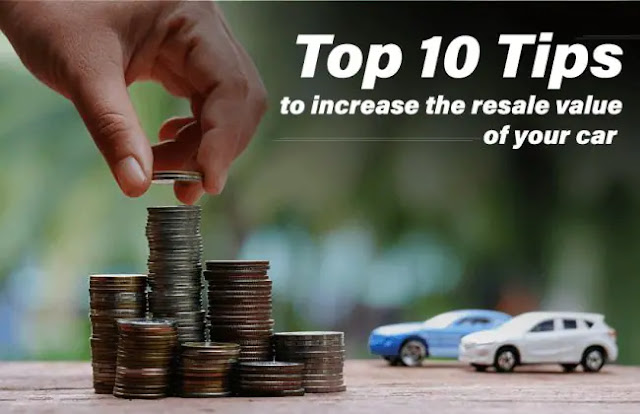You’ve probably heard this before: as soon as you drive your new vehicle off the dealership lot, it starts to depreciate in value. Depreciation is one of the most expensive components of vehicle ownership and plays a key role in the return on your investment.
After years of use, general wear and tear and racking up mileage, your vehicle’s life is not only decreased, so is its value. If you’re planning to buy a vehicle to drive for 2-5 years, you’ll likely be looking to trade it in or sell it after that time. How much your vehicle is currently worth is its resale value, or initial value, minus depreciation over the time you’ve owned it.
Although you won’t get the same price you paid for your vehicle, there are certain ways to reap the most return possible, ensuring you won’t take a huge financial hit. We all have good intentions when making a new vehicle purchase. However, putting in work along the way, including regular maintenance is a must.
(toc)
But where should you start and what’s necessary to protect your vehicle’s resale value.
Follow these 12 tips to protect your car’s resale value:
Shop smart: stay within your budget
When shopping for your next vehicle, make the decision by prioritizing what will work for your budget. Do your research before you buy–ensure you’re getting the best deal possible for the make, model, and features that fit your lifestyle and budget.
By ensuring you’re within your budget and opting for the best value possible, you’ll lessen the financial impact when it comes time to sell. If you’re barely able to make your car payments in the first place, that’s a major red flag.(ads1)
Buy a vehicle with a high residual value
Strong residual values help you maximize your return when it comes time to trade-in or sell your car. Understanding how much your vehicle will depreciate will help you maximize your overall investment.
Do a little research and read up on which vehicle makes and models that have the highest residual value. A high residual value means that a specific vehicle retains the highest percentage of its initial value.
Drive smart by driving less
Driving smart is more than avoiding careless driving, although reckless driving is definitely not advisable if you want to avoid unnecessary vehicle damage and wear. Drive less when possible, because it’s no secret that keeping the kilometres down can keep your vehicle’s value up.
Planning on taking a road trip? Save your personal vehicle from unnecessary wear and racking up mileage. If your trip or long-haul drive is going to rack up the odometer, consider renting, it might actually be the more affordable option in the end. Plus, opting for a compact fuel-efficient vehicle for long trips could save you money overall.
Park smart: avoid depreciating dings and dents
A potential buyer notices your vehicle’s exterior first. So don’t let a dent diminish your chances of selling and receiving the best return on your ride. Minimize dings, dents, and scratches by parking away from other cars–plus a few extra steps to your destination from the parking lot is great exercise!
If it’s not possible, ensure there’s enough space between your car and your neighbour’s. Avoid parking too closely to another vehicle to help prevent the swipe of a car door or an accidental bump when backing out of a spot. When you have the option, choose underground, garage, or covered parking to shelter your vehicle from environmental factors that can tarnish its exterior.
Fix dings and dents right away
Dings and dents will happen even if you’re a conscientious driver and park carefully. Don’t let dings and dents slide by! Repair them as they happen. When you notice a dent, fix it as soon as you can, because invariably one leads to another and you may end up with a lot to fix when it comes time to sell. A paintless dent repair technician can quickly and easily fix the situation, usually for less than a couple hundred dollars.
Safeguard areas prone to wear
Certain areas and parts of your vehicle are more vulnerable to environmental damage. Luckily there are many affordable things you can do to protect areas of your vehicle that are prone to wear and tear. The front end gets lots of exposure, and thus wear and damage, especially if you drive on gravel roads.
Protect your vehicle’s front end from dings, dents, and scratches by getting a clear plastic applied at your dealership or an autobody shop. Another great option is to add carbon fibre tape or black vinyl wrap to other high-wear areas such as ahead of your rear wheel, doorsills, and the top of your rear bumper. When it comes time to sell, simply remove or replace the clear wrap and carbon fibre tape. Mudguards will also help protect from damage or buildup of unwanted grime.
Slow down the rust process
The undercarriage of your vehicle–the frame and components of the under body–are prone to deterioration and eventually rusting due to salt, sand, and grime year round. Rust can really add to depreciation, so turn to a little oil to help halt the process of rusting. Get your car’s undercarriage oil sprayed, just be mindful not to spray by the engine bay.
Wash and wax your car regularly.
Let your car make a shining first impression by washing and waxing regularly to maintain a flawless-as-can-be finish. During warmer months, it’s recommended to wash twice a month. If you’re washing your car yourself, make sure to use soap specifically designed for this purpose.
When you’re not washing by hand, stick to self-spraying or a touchless car wash and avoid a tumble or swirling car wash, as they are abrasive on your vehicle’s exterior. In winter months when roads are full of salt and sand, wash your vehicle weekly. One last element to keep your car sparkly is to wax 2-3 times a year, in order to prevent fading, buff out small blemishes, and remove dirt and materials adhered to the surface.(ads2)
Invest in winter tires
If you live somewhere with a snowy, icy season, getting a set of winter tires can help prevent accidents that could do some serious damage to your car. Having another set of tires also prolongs the tread and life of each one, thus adding to the overall resale value. It’s also beneficial to stow away your rims during winter, when they’re most exposed to sand and salt, to keep them in the best shape possible.
Maintain the interior
Your car’s exterior might give the first impression but it’s equally important to maintain the interior. The inside of your vehicle adds to the value and a few simple measures can really add up. Even the small task of keeping trash out of your car helps form positive habits that will ensure your interior stays in tip-top shape.
The first tip is to use the original equipment from the manufacturer (OEM), such as rubber mats year round. If you don’t have OEM rubber mats, buy some fitted mats to keep salt, dirt, water, and other liquids from damaging the carpet. Give the mats a good shake on a regular basis, wipe down your dash occasionally, and chuck out any garbage on a daily basis.
If you have leather interior, purchase some conditioner. Leather interior or not, if you have pets or children that will be riding in the car, put a cover or blankets over seats to protect from scratches and damage.
Here are a few extra tips on how to keep your car clean:
Regular maintenance is key.
This tip might seem like a no-brainer; however, regular maintenance is critical to maximizing your vehicle’s resale value. Being on top of maintaining your vehicle can stop any damage before it occurs or tackle small issues before they become larger, expensive issues to fix. Simple measures will help major components of your vehicle last as long as they were intended.
Just like you visit your doctor for an annual check-up; ensure you take your car in for a tune-up every 50,000km or at least once a year. It’s also important to get an oil change once a season or roughly every 3 months. Changing your oil is one of the best ways to keep your engine and car running smoothly.
Not sure how much money to set aside for car maintenance? See our blog post How to Budget for Car Maintenance.
Keep all receipts and records
Last but not least, hold on to all records you have from repair and maintenance no matter how small. Having all the receipts handy shows that you’re diligent and lets prospective buyers know that everything was well taken care of.
It’s also necessary to include the original car manual and other important documents that you received with the vehicle to pass along to the next owner. Unfortunately, you’ll likely never get back all the money you put in to your vehicle, so you may as well maximize the return on your investment.
Follow these 12 tips and you will be on the road to reaping the best possible resale value.
At Birchwood Credit Solutions, we’re committed to getting you in a vehicle as fast as possible. Our customers include people who are new to Canada, recently went through bankruptcy, are going through divorce or have yet to build any credit. We can help any type of credit situation. Fill out our online application to find a vehicle that works for your budget and lifestyle.






